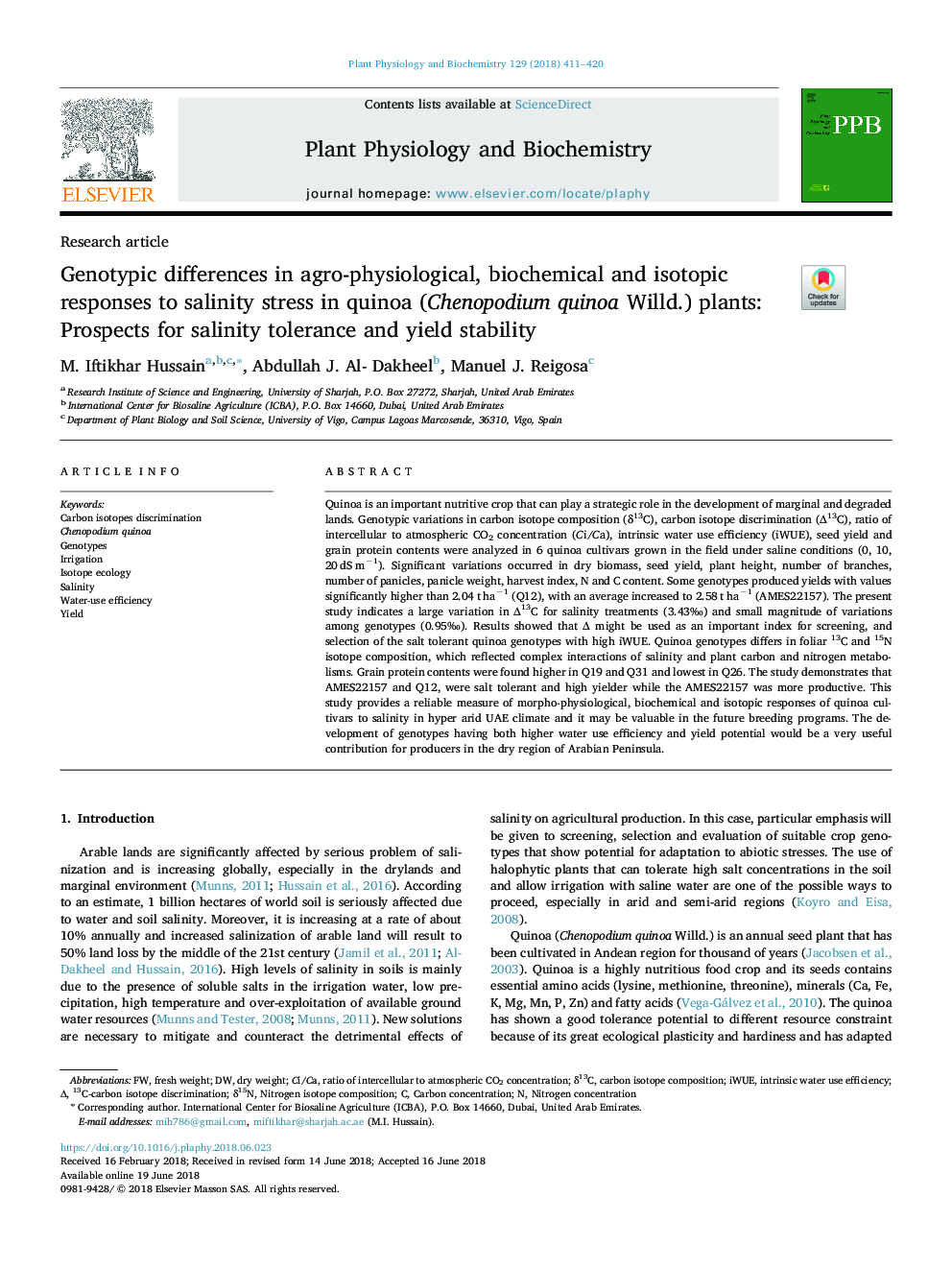| کد مقاله | کد نشریه | سال انتشار | مقاله انگلیسی | نسخه تمام متن |
|---|---|---|---|---|
| 8352889 | 1541892 | 2018 | 10 صفحه PDF | دانلود رایگان |
عنوان انگلیسی مقاله ISI
Genotypic differences in agro-physiological, biochemical and isotopic responses to salinity stress in quinoa (Chenopodium quinoa Willd.) plants: Prospects for salinity tolerance and yield stability
دانلود مقاله + سفارش ترجمه
دانلود مقاله ISI انگلیسی
رایگان برای ایرانیان
کلمات کلیدی
δ13CChenopodium quinoaiWUECi/Ca - CI / کلسیمδ15N - d15NIrrigation - آبیاریYield - بازدهWater-use efficiency - بهره وری استفاده از آبCarbon isotope composition - ترکیب ایزوتوپ کربنIntrinsic water use efficiency - راندمان مصرف آب ذاتیSalinity - شوریNitrogen concentration - غلظت نیتروژنCarbon concentration - غلظت کربنfresh weight - وزن ترdry weight - وزن خشکGenotypes - ژنوتیپ
موضوعات مرتبط
علوم زیستی و بیوفناوری
علوم کشاورزی و بیولوژیک
دانش گیاه شناسی
پیش نمایش صفحه اول مقاله

چکیده انگلیسی
Quinoa is an important nutritive crop that can play a strategic role in the development of marginal and degraded lands. Genotypic variations in carbon isotope composition (δ13C), carbon isotope discrimination (Î13C), ratio of intercellular to atmospheric CO2 concentration (Ci/Ca), intrinsic water use efficiency (iWUE), seed yield and grain protein contents were analyzed in 6 quinoa cultivars grown in the field under saline conditions (0, 10, 20â¯dSâ¯mâ1). Significant variations occurred in dry biomass, seed yield, plant height, number of branches, number of panicles, panicle weight, harvest index, N and C content. Some genotypes produced yields with values significantly higher than 2.04â¯tâ¯haâ1 (Q12), with an average increased to 2.58â¯tâ¯haâ1 (AMES22157). The present study indicates a large variation in Î13C for salinity treatments (3.43â°) and small magnitude of variations among genotypes (0.95â°). Results showed that Î might be used as an important index for screening, and selection of the salt tolerant quinoa genotypes with high iWUE. Quinoa genotypes differs in foliar 13C and 15N isotope composition, which reflected complex interactions of salinity and plant carbon and nitrogen metabolisms. Grain protein contents were found higher in Q19 and Q31 and lowest in Q26. The study demonstrates that AMES22157 and Q12, were salt tolerant and high yielder while the AMES22157 was more productive. This study provides a reliable measure of morpho-physiological, biochemical and isotopic responses of quinoa cultivars to salinity in hyper arid UAE climate and it may be valuable in the future breeding programs. The development of genotypes having both higher water use efficiency and yield potential would be a very useful contribution for producers in the dry region of Arabian Peninsula.
ناشر
Database: Elsevier - ScienceDirect (ساینس دایرکت)
Journal: Plant Physiology and Biochemistry - Volume 129, August 2018, Pages 411-420
Journal: Plant Physiology and Biochemistry - Volume 129, August 2018, Pages 411-420
نویسندگان
M. Iftikhar Hussain, Abdullah J. Al- Dakheel, Manuel J. Reigosa,